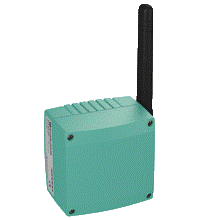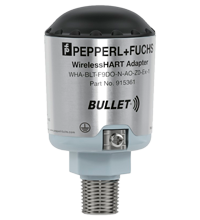Transmitting small amounts of data over long distances is one of the challenges in process plants.
Comparing Three Different Types of WirelessHART Adapters
Sabrina Weiland | Pepperl+Fuchs
Transmitting small amounts of data over long distances is one of the challenges in process plants. With WirelessHART technology, this can be done efficiently: communicating field signals wirelessly saves time and reduces costs while enabling consistent and safe communication between the field and control side—even in large-scale plants.

To make this possible, WirelessHART adapters are used to allow field devices to communicate in a WirelessHART network. They read the data from the field device via HART, or translate the 4 mA … 20 mA signal into a digital value, which is then transmitted to the WirelessHART network.
The process industry offers you several kinds of adapters with different strengths, depending on the application they are needed for. Below, we introduce three different adapter types from the Pepperl+Fuchs portfolio and offer advice to help you decide which one is right for you.
1. Battery-powered adapter
Profile: Battery-powered adapters supply themselves and the connected field device with power while the adapter is permanently active as a router and repeater within the network. The adapter only activates the field device when measurements need to be taken. Since the adapter’s battery powers the field device, energy consumption and battery lifetime depend on the type of application you are running. You can easily check the remaining power with the “Battery Lifetime Tool.”

Installation: flexible mounting options are a key feature for this adapter. You can mount it directly at the cable entry of the field device, or detached via a short connection cable- on a pipe, for instance. With an antenna that rotates nearly 360°, optimal antenna orientation and signal transmission are easily ensured. For Zone 1 and non-hazardous areas, this adapter is available in a plastic housing. For mounting in gas and dust explosion-hazardous areas of Zone 1 or 21, or Class I, Div. 1, there is also a version with an aluminum housing.
Best practice: Battery-powered adapters are the right choice when you want to establish autonomous measurements with low energy consumption in your process.
Application details: This adapter version is especially suited to test setups and mobile measurements, as it is installed so quickly and easily. Also, when sensors are spread out over long distances, or you have high installations, or rotating machine parts, the battery-powered WirelessHART adapter is an efficient alternative to conventional wiring methods. For instance, even today, there are countless tanks whose fill levels are checked manually and are not fully automated. That can easily be improved by combining a standard fill level sensor with a WirelessHART adapter: Slowly-changing fill levels are perfectly suited to monitoring via a WirelessHART network.
In addition, you can verify the precise calibration of the field device. When the 4 mA … 20 mA value differs from the digital HART variables, the current loop most likely needs to be readjusted. Thus, you can test the validity of conventional measurements and—in case of discrepancies—take action in time.
2. Loop-powered WirelessHART adapter
Profile: The Bullet WirelessHART adapter encapsulates the antenna with an extremely robust aluminum housing. Available in an Ex d version, it allows the easy integration of flameproof field devices into a WirelessHART network. In protection type Ex i, this adapter features intrinsically-safe connections for use with Ex i rated field instrumentation.

Installation: The loop-powered adapter can be connected to the 4 mA … 20 mA loop at any point. Alternatively, you can also apply it as a mains-powered adapter (7... 32 V) or even use a solar panel as a power supply. Using the Ex d version, you are able to easily integrate flameproof field devices into a WirelessHART network. The Bullet can be installed directly, via a conduit on the Ex d field device, or via a terminal box. These Ex d to Ex d configurations are possible up to Zone 1 or 21 and Class I, Div 1. Due to its intrinsically-safe connections, the Ex i version is suitable for Ex i field instrumentation and can be used up to Zone 0 or 20, and Class I, Div. 1.
Best practice: Used as a loop-powered adapter, the Bullet is especially suitable when you want to add additional measurements and/or you want to transmit diagnostic data from installed HART measuring points.
Application details: This adapter is applied in tank farm applications where many sensors are installed. With Multidrop technology, you can connect up to eight field devices to just one loop-powered adapter in order to transmit HART data. Further, you can add new field devices—without having to worry about possible power shortages. Due to patented “StepVolt” technology, the power drop in the loop remains very low when new field devices are added. The Bullet is also a great option for plants in which dirt and moisture are prevalent, for instance in paper mills. Thanks to its robust aluminum housing and fully encapsulated antenna, it can withstand extreme ambient conditions.
3. Mains-powered WirelessHART adapter
Profile: This WirelessHART adapter with a plastic housing can use every available current source, such as existing junction boxes or power buses (24 VDC, 115 VAC / 60 Hz, 230 VAC / 50 Hz).
.png)
Installation: Either attach this adapter directly to the field device, or use a dropped cable to better adjust it to the direction of wireless communication signals. Technically, this adapter is not entirely wireless since a cable is required to connect it to a nearby current source—but this is all the wiring effort needed.
Best practice: When you transmit data wirelessly and your field devices have a higher power consumption, this adapter is a great fit.
Application details: Several factors can lead to a higher power consumption: Long boot sequences take time until the device finally transmits a measured value. Also, longer measuring times or very short measurement intervals can cause more power consumption. This applies for ultrasonic measurements, for instance. Due to continuous updates, the field devices are constantly active, so those applications require a great deal of energy. In these cases, the adapter with a wide-range power supply is the right choice.
The content & opinions in this article are the author’s and do not necessarily represent the views of ManufacturingTomorrow
Comments (0)
This post does not have any comments. Be the first to leave a comment below.
Featured Product

